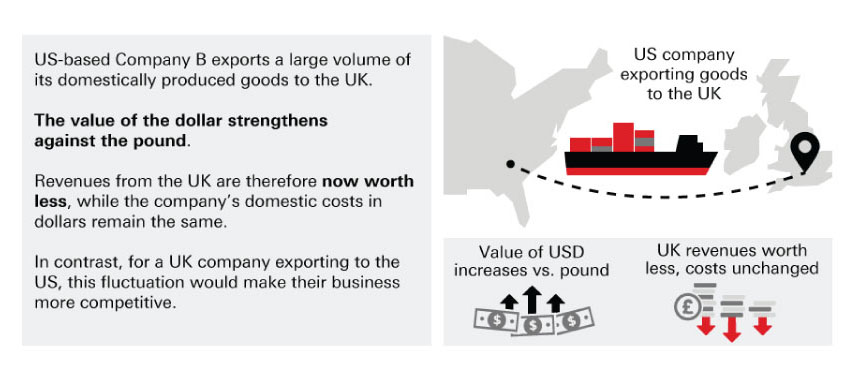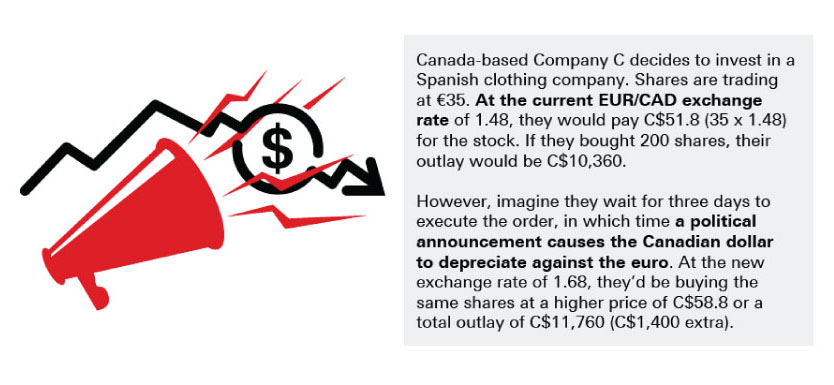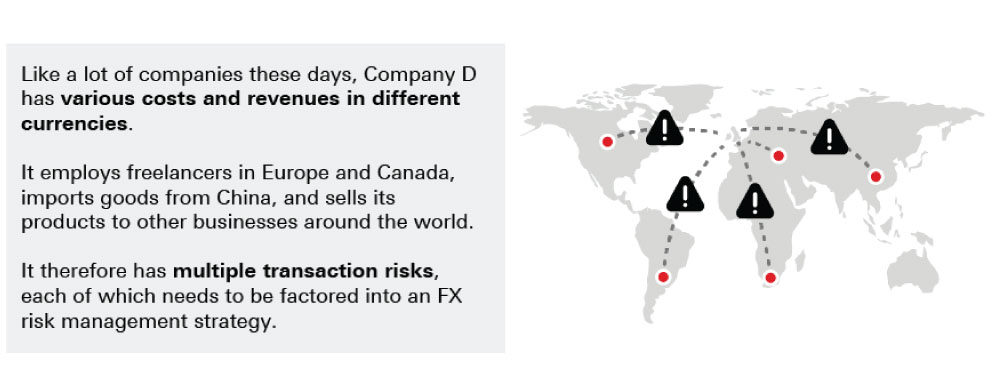- Article

- Managing Cash Flow
- Improve Efficiency
Understanding the Fundamentals of Foreign Exchange Risk in 5 minutes
Doing business on a global scale comes with certain risks. If you’ve got five minutes, we’ve got all you need to grasp the basics of foreign exchange risk.
Transactions in foreign currencies put you at the mercy of fluctuations in exchange rates. If they go one way, you could reap the rewards. If they go the other way, your profits could take a hit.
To help you navigate the risk of overseas transactions in uncertain times, we’ve summarised the essential info you should bear in mind.
Four examples of foreign exchange risk
Six ways to manage your foreign exchange risk
Quantify your FX risk
You can’t manage your FX risk unless you’re aware of every part of your business that involves foreign currency. Make a list of everything that isn’t in your base currency, e.g.:
- Overseas revenues
- Paying remote freelancers and employees in their own currencies
- Importing raw materials
- Investments in global stocks, funds, and bonds
- Large one-off expenses, such as opening an overseas office
For each item, list the amount it’s currently worth according to the exchange rate between your home currency and the foreign currency. You can use these figures to run various scenarios and test how fluctuations could help or hurt your revenue. For example, what would happen if your home currency suddenly dropped by 20 per cent against the other currencies to which you have exposure? Could your cash flow survive, or would you need more working capital to stay afloat?
Require payment in your domestic currency
This puts the onus of bearing fluctuations in the exchange rate on your customers. It’s a simple solution but could make it harder to do business if competitors are willing to offer customers less risky transactions in their home currency.
Prioritise prompt payments
Setting shorter payment terms can limit the amount of time you’re exposed to the currency market. You should also aim to close the gap between agreeing on deals with your customers, clients, and suppliers and settling transactions for those deals.
Charge more to account for potential fluctuations
If a client’s currency fluctuates by around 3 per cent per year relative to your currency, you could charge 3 per cent more in that country. It might not work if it changes by more than 3 per cent or the market won’t support the increase, but otherwise, it could help you manage the risk.
Consider important risk metrics
The most common tools for measuring FX risk are:
Value-at-Risk (VaR) - An estimate of how much you might lose or gain under normal currency market conditions over a set period.
Cash-Flow-at-Risk (CFaR) - How future cash flow may change over a set period as a result of FX market fluctuations.
Earnings-at-Risk (EaR) - How much your income may change over a set period based on previous earnings figures. The longer the time period, the higher the FX risk.
These calculations are worth looking into if a large proportion of your business relies on imports, exports, or foreign investment.
Lock in a fixed rate
There are financial products you can use to set an exchange rate so you know exactly how much a transaction will be worth when you make it.
A forward exchange contract locks in an exchange rate for a future transaction, thereby protecting against a disadvantageous movement. However, if the rates move in a way that would have saved or made money, you have to stick to the rate you agreed with your bank.
If you want to find out how your transactions could be affected by the pandemic, or are looking to expand your business into new markets, there are several options to help manage your FX risk. Should you wish to discuss how HSBC may assist you or your business in respect of any of the matters discussed in any of these articles, or anything else, and you are not already an HSBC customer, please contact us by clicking on the “Get In Touch” button below.
Disclaimer
This article has been issued to you by the [HSBC Bank Middle East Limited (“HBME”), acting through its [Dubai branch], whose registered address is at [HSBC Tower, Downtown, P.O. Box 66, Dubai, United Arab Emirates (the “UAE”)]. HBME is regulated for these purposes by [the Central Bank of the UAE and the Dubai Financial Services Authority] and is a member of the HSBC group of companies (the “HSBC Group”).
The information contained in this article has been obtained by us from publicly available sources and we are providing it to you on an "as is" basis for informational purposes only. It may not be accurate or reliable or fit for any particular purpose and you must ensure you conduct your own due diligence.
This article has not been issued by a research department of HBME or the HSBC Group. You must make your own determination and investment decisions. Any views expressed in this article is based on individual opinions of the authors and may differ from the opinions expressed by HBME or any other HSBC Group divisions or entities, including their research departments. Neither HBME nor any member of the HSBC Group accepts any liability whatsoever or howsoever arising in relation to the provision or use of the information contained in this article. Neither HBME nor any member of the HSBC Group has verified, assessed or made any inquiries into the information provided and makes no representations or warranties in relation to such information.
HBME has obtained this information from sources it believes to be reliable but which have not been independently verified. Opinions and estimates expressed therein are the present opinions of the author only and may change at any time without notice. Any charts and graphs included are from publicly available sources or proprietary data. Any indicative trade details provided should not be regarded as complete or as representing the actual terms on which HBME or any other HSBC Group company may trade. Figures included in this article may relate to past performance or simulated past performance (together “past performance”). Past performance is not a reliable indicator of future performance.
You are solely responsible for making your own independent appraisal of and investigation into the products, investments and transactions referred to in this article and you should not regard any information in this article as constituting investment, financial or other advice. Neither HBME nor any member of the HSBC Group is responsible for providing you with legal, tax or other specialist advice.
Except in the case of fraudulent misrepresentation, neither HBME nor any member of the HSBC Group nor any of their officers, directors, employees or agents accepts any liability for any loss or damage arising out of the use of all or part of this article.
Reproduction of this article, in whole or in part, or disclosure of any of its contents, without the prior consent of HBME, is prohibited. This article is not intended for distribution to, or use by, retail clients or any person or entity in any jurisdiction or country where such distribution would be contrary to any law or regulation.
No company, agency, or any third party mentioned in this article is affiliated, associated, authorised, endorsed by, or in any way officially connected with HBME and/or any other HSBC Group company. The use of any trade name or trademark is for identification and reference purposes only and does not imply any association with the trademark holder of their product brand.






